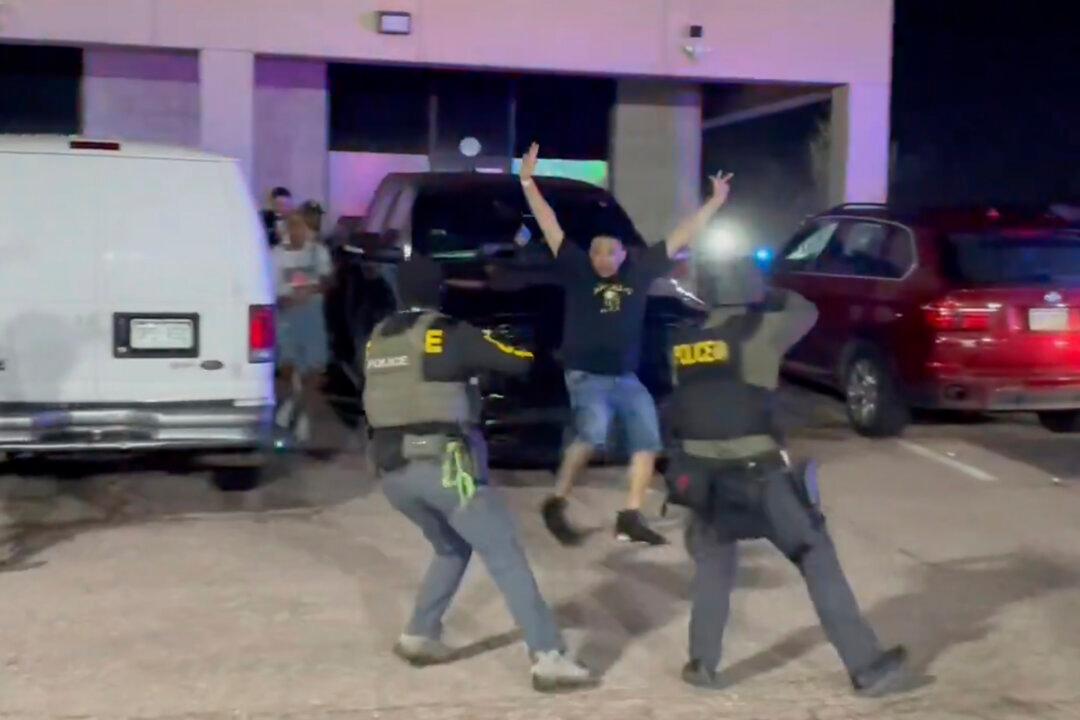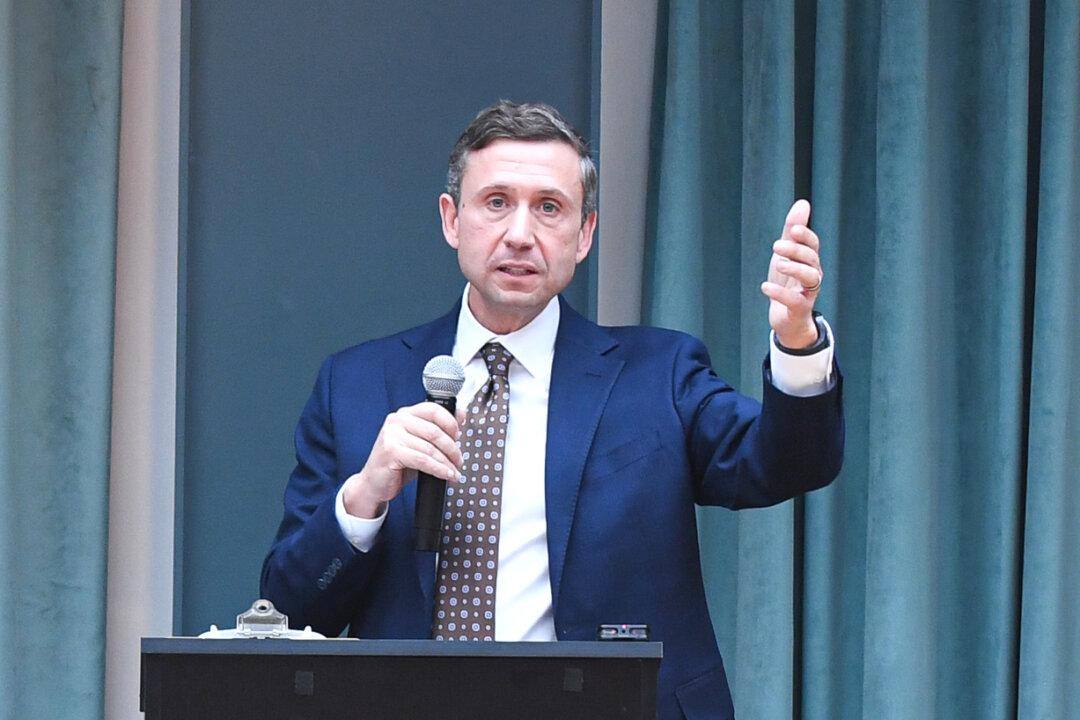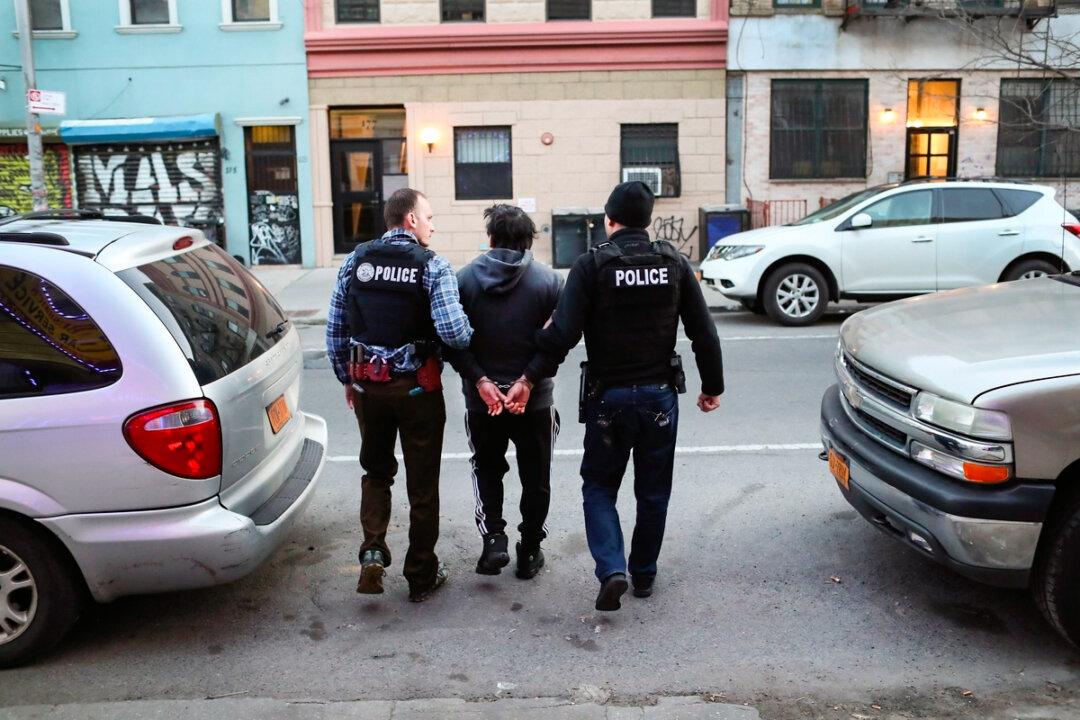During its eighth public hearing on July 21, the House January 6 Committee unveiled testimony and videos alleging to show that President Donald Trump was too slow to condemn the violence at the Capitol on Jan. 6, 2021.
The hearing, led by Reps. Elaine Luria (D-Va.) and Adam Kinzinger (R-Ill.), focused on the so-called “187 minutes” between President Donald Trump’s speech at the Ellipse and his video telling supporters at the Capitol to disperse on January 6.
In an interview before the hearing, Luria presaged the tone the hearing would take, saying that Trump “was doing nothing to actually stop the riot.”
This claim, that Trump failed to take sufficient action in a timely manner, was at the heart of the committee’s presentation on Thursday.
Trump’s Actions During the ‘187 Minutes’ According to the January 6 Committee
Broadly, the committee on Thursday attempted to give a minute-by-minute account of Trump’s actions on January 6, starting at 1:10 p.m. ET upon the conclusion of his speech at the Ellipse and ending at 4:17 PM with his social media video telling supporters to disperse.At the end of his Ellipse speech, Trump called on supporters to march to the Capitol in order to protest the certification of electoral slates by Congress.
“So we’re going to walk down Pennsylvania Avenue—I love Pennsylvania Avenue—and we’re going to the Capitol,“ Trump said. ”And we’re going to try and give—the Democrats are hopeless, they’re never voting for anything, not even one vote—but we’re going to try and give our Republicans—the weak ones, because the strong ones don’t need any of our help—we’re going to try and give them the kind of pride and boldness that they need to take back our country.”
In brief, Trump hoped that the protest might be enough to convince Republicans to approve objections to the certifications of slates where Trump and his allies suspected widespread voter fraud.
The committee places the end of the “187 minutes” at 4:17 p.m. ET, following the release of a video posted by Trump on social media telling his supporters to go home.
“I know your pain. I know you’re hurt. We had an election that was stolen from us. It was a landslide election, and everyone knows it— especially the other side—but you have to go home now,“ Trump said in the video. ”We have to have peace. We have to have law and order. We have to respect our great people in law and order. We don’t want anybody hurt. It’s a very tough period of time. There’s never been a time like this where such a thing happened, where they could take it away from all of us—from me, from you, from our country. This was a fraudulent election, but we can’t play into the hands of these people. We have to have peace. So, go home. We love you. You’re very special. You’ve seen what happens. You see the way others are treated that [is] so bad and so evil. I know how you feel. But go home and go home in peace.”
What happened in between is based largely on testimony about his actions that day made by those reportedly close to the president.

Jan. 6 Committee Accused Trump of Inaction, Ignoring His Tweets Condemning Capitol Violence
Generally, testimony displayed by the committee on Thursday echoed the general attitude expressed by Trump lawyer Eric Herschmann, who reportedly told White House counsel Pat Cipollone that Trump “didn’t want anything done” as the Capitol breach unfolded.To demonstrate this, the committee claimed that the Pentagon called the White House during the Capitol breach to plan a response, but Trump reportedly refused to take the call; rather, Cipollone took the call himself, Luria said.
It was around this time that Herschmann reportedly told Cipollone that Trump “didn’t want anything done.”
Herschmann’s comments echo similar comments in contested testimony by former White House Aide Cassidy Hutchinson, who said that chief of staff Mark Meadows “looked up at [Cipollone] and said, ‘he doesn’t want to do anything, Pat,’” after Cipollone tried to demand a meeting with Trump.
After refusing to take the call from the Pentagon, Luria said, citing “numerous interviews with senior law enforcement and military leaders, Vice President [Mike] Pence’s staff and DC government officials,” that “none of them, not one, heard from President Trump that day. He did not call to issue orders. He did not call to offer assistance.”
At the same time, the committee claimed, Trump was aware of the breakdown of peace at the Capitol within 15 minutes of the Capitol breach.
According to the committee, Trump entered the private dining room just off the Oval Office at around 1:25 PM ET, 20 minutes after the Capitol breach began and 15 minutes after leaving his stage at the Ellipse.
“From 1:25 until after 4:00, the President stayed in his dining room,” the committee said.
Not mentioned by the committee were several tweets Trump made during the “187 minutes” urging his supporters at the Capitol to be peaceful.
“Please support our Capitol Police and Law Enforcement,” Trump wrote at around 2:38 p.m. ET according to tweets archived by the American Presidency Project. “They are truly on the side of our Country. Stay peaceful!”
While in the dining room, Trump was reportedly watching the events unfold on Fox News. However, during that time Trump allegedly refused to allow the White House photographer to take any photos, and none have been recovered of the president during this timeframe.
Cipollone, who said he was with Trump as he sat in the dining room, claimed to have no knowledge of Trump making any efforts to coordinate a response to the violence unfolding at the Capitol with the secretary of defense or attorney general.
Keith Kellogg, former national security adviser to Pence, echoed the claim, saying that he would have known if any such request had been made.
Trump Advisers, Staff Demanded Stronger Condemnation
The committee also detailed how Trump reportedly was alone in his opposition to an immediate response to the Capitol breach.Cipollone detailed in testimony how he and several other top players in the White House—including Trump’s daughter Ivanka Trump, son-in-law Jared Kushner, and Mark Meadows—spent much of the three-hour period after the speech at the Ellipse pushing the president to issue a condemnation of the attack.
“I think I was pretty clear there needed to be an immediate and forceful response, statement, that people need to leave the Capitol now,” Cipollone said in testimony.
An investigator asked Cipollone: “So your advice was tell people to leave the Capitol, and that took over two hours when there were subsequent statements made, tweets put forth, that in your view were insufficient. Did you ... up until 4:17 continue, you and others, to push for a stronger statement?”
“Yes,” Cipollone replied.
“Were you joined in that effort by Ivanka Trump?”
“Yes,” Cipollone repeated.
Later in his testimony, Cipollone summarized that the attitude that Trump needed to condemn the attack was shared by, “Overall, Mark Meadows, Ivanka [Trump]. Once Jared [Kushner] got there, Jared, General [Keith] Kellogg,” he continued. “I’m probably missing some, but those are—[former White House Press Secretary] Kayleigh [McEnany] was there.”
Asked whether anyone “on the staff” or “in the White House” did not share the attitude, Cipollone replied, “I can’t think of anybody on that day who didn’t want people to get out of the Capitol—particularly once the violence started.”

Witnesses Allegedly Corroborate White House Aide Cassidy Hutchinson’s Contested Testimony
During testimony to the committee at the end of June, Meadows aide Cassidy Hutchinson related several alleged disputes between Trump and the Secret Service on Jan. 6.According to Hutchinson, the first of these came during Trump’s rally at the Ellipse.
The rally, Hutchinson claimed, looked too small to Trump. She said he blamed this on the use of magnetometers by the Secret Service. Magnetometers, used by security forces to detect weapons, had been placed at the entrance to the Trump rally that day.
Upset by the smaller crowd size, Trump allegedly asked the Secret Service to remove them.
“‘I don’t [expletive] care that they have weapons, they’re not here to hurt me, take the [expletive] mags away,‘” Hutchinson claimed Trump said. “‘Let my people in, they can march to the Capitol from here. Let the people in. Take the [expletive] mags away.’”
Later, Hutchinson said, Trump grew frustrated after the Secret Service refused to allow him to join supporters at the Capitol protest because the area had not been secured. Hutchinson then claimed that Trump lunged at a Secret Service agent in anger after they refused to take him to the Capitol before trying to seize the steering wheel from the driver of the White House limousine.
The charge has been denied by both Trump himself and, reportedly, by Secret Service agents who were with Trump that day.
Before the beginning of the hearing, Luria claimed that the committee had obtained testimony from two other witnesses purportedly corroborating the story.
Though details given by Luria were sparse, she said that one of the witnesses—who Luria said was a “former White House employee with national security responsibilities”—had heard the same story from deputy chief of staff Tony Ornato. Specifically, the unnamed witness was told that Trump was “irate” when Bobby Engel, who was in charge of security that day, refused to allow him to go to the Capitol to join his supporters.
However, these claims leave out the most explosive of Hutchinson’s claims, suggesting only that there was a conflict but failing to corroborate Hutchinson’s claim that Trump became aggressive with Secret Service agents.
In a post on Truth Social following Hutchinson’s testimony, Trump said, “[Hutchinson’s] Fake story that I tried to grab the steering wheel of the White House Limousine in order to steer it to the Capitol Building is ‘sick’ and fraudulent, very much like the Unselect Committee itself. Wouldn’t even have been possible to do such a ridiculous thing.”
Earlier in the day, Trump had also indicated that Hutchinson was far removed from his inner circle, casting further doubt on her claims.
“I hardly know who this person, Cassidy Hutchinson, is, other than I heard very negative things about her (a total phony and ‘leaker’),” Trump said.
Reports have also come in from Secret Service agents suggesting that Hutchinson’s claims about Trump lunging at and trying to seize control of the White House limo were false.
Reportedly, a source close to the Secret Service told NBC’s Peter Alexander that “both Bobby Engel, the lead agent, [and the agent allegedly lunged at by Trump] and the presidential limousine/SUV driver are prepared to testify under oath that neither man was assaulted and that Mr. Trump never lunged for the steering wheel.”
Hearing Comes After Batch of Subpoenaed Secret Service Docs Leave Out Jan. 5, Jan. 6 Texts
Thursday’s hearing came after a delivery of text messages and other documents by the Secret Service disappointed committee expectations when it was revealed that they did not include text messages between agents on Jan. 5 and 6, 2021.Many messages, delivered in accordance with a committee subpoena, had been “erased,” panel member Stephanie Murphy (D-Fla.) told MSNBC during a July 19 appearance.
“We received a letter today that did provide us with a lot of documents and some data. However, we did not receive the additional text messages that we were looking for,” Murphy said during the TV appearance.
The texts were allegedly erased after a device replacement program upgraded the mobile devices of Secret Service agents, Murphy said.
“They moved ahead with their efforts to migrate the devices and the data, and their process, as explained to us, was simply to leave it to the agent to determine whether or not there was anything on their phones worth saving that was necessary to save for federal records,“ Murphy explained. ”And as a result, today they did not receive any texts from their agents when they made that transition that was flagged for preservation.”
However, the Secret Service has denied the charge that they erased any text messages, a charge first reported to the Jan. 6 panel by Department of Homeland Security (DHS) Inspector General Joseph Cuffari.
Secret Service spokesman Anthony Guglielmi said in a statement to another media outlet that there were no “hidden messages” or other information that the Secret Service was “holding out” from the panel.
The missing texts, Guglielmi said, can largely be explained by an agency policy that generally frowns on the use of texts when discussing security situations.
“It’s hard for people to understand, but we do not communicate via text message,” he said. “It is in policy that you do not conduct business via text message.”
Guglielmi maintained that there was no malicious intent on the part of the Secret Service.
“There’s no reason for us to say the texts were lost,” he said. “I mean, how do you know that those people texted? They were told to upload their official records, and they did. So this is partly what we’re going to communicate to the committee, all of the data that we have. People say texts were lost. How do you know texts were sent?”
On the other hand, Murphy said that if a device upgrade program was responsible for the loss of any text messages, Secret Service leadership had received congressional orders to retain texts and should have done more to ensure their preservation.
Committee to Reconvene Next In September
The hearing on Thursday will be the last until September, Chairman Bennie Thompson announced at the hearing’s opening.“Our investigation goes forward,” Thompson said. “We continue to receive new information every day. We continue to hear from witnesses. We will reconvene in September to continue laying out our findings to the American people.”
“As that work goes forward, a number of facts are clear: there can be no doubt that there was a coordinated, multi-step effort to overturn an election overseen and directed by Donald Trump,” Thompson said.
Also speaking at the start of the hearing, Ranking Member Liz Cheney (R-Wyo.) said that “the dam has begun to break” with new testimony.
“In the course of these hearings, we have received new evidence, and new witnesses have bravely stepped forward. Efforts to litigate and overcome immunity and executive privilege claims have been successful and those continue. Doors have opened, new subpoenas have been issued, and the dam has begun to break,” Cheney said.
Hope of Trump Indictment, Preventing Possible Reelection Bid, Underpins Hearings
Members of the Democrat-dominated January 6 Committee have made no effort to hide their hope that Trump will face criminal charges for his actions on and leading up to Jan. 6, 2021. Charges that lead to a conviction of insurrection may put an end to his chances of running for re-election, which he has indicated he may do.“I would like to see the Justice Department investigate any credible allegation of criminal activity on the part of Donald Trump or anyone else,” Rep. Adam Schiff (D-Calif.) in June said on ABC News’ “This Week.” “They need to be investigated if there’s credible evidence, which I think there is.”
Rep. Jamie Raskin (D-Md.) said the committee has laid out in various legal pleadings “the criminal statutes that we think have been violated,” and claimed that the panel has evidence that Trump knew Democratic rival candidate Joe Biden won the 2020 election.
“I think we can prove to any reasonable, open-minded person that Donald Trump absolutely knew because he was surrounded by lawyers,” Raskin said on CNN’s “State of the Union.” “He continues to spread [doubts about the 2020 election results] to this very day. He continues to foist that propaganda on his followers.”
“I certainly think the president is guilty of knowing what he did,” Kinzinger said when asked during an appearance on ABC’s “This Week” if Trump should face criminal charges. “Seditious conspiracy. Being involved in these, you know, kind of different segments of pressuring DOJ, Vice President, etc.”
It remains unclear whether the DOJ will take the unprecedented step of opening a criminal investigation of Trump, whatever the calls from members of the panel.





